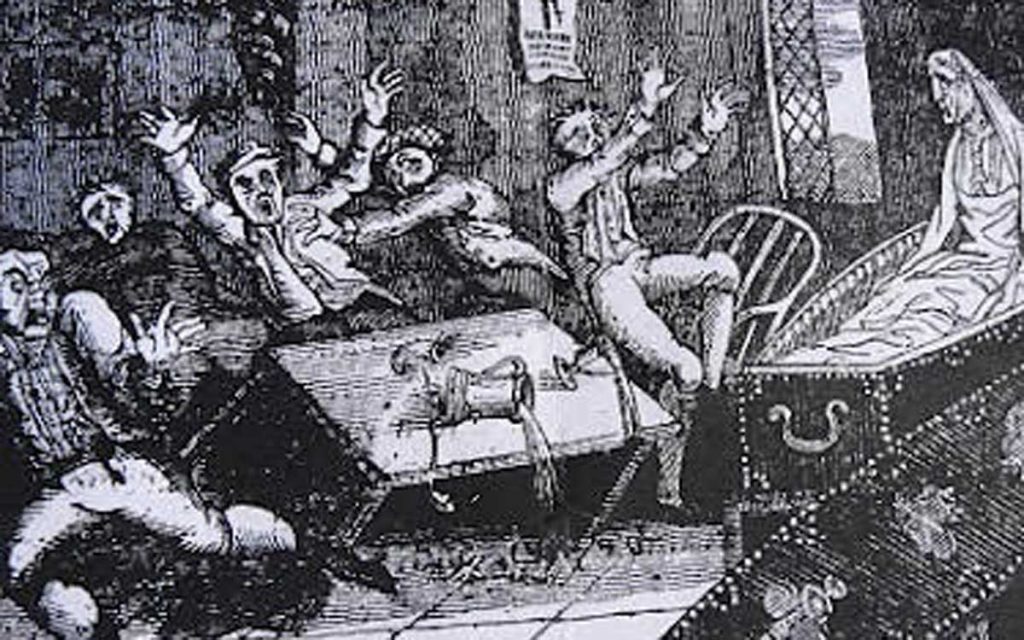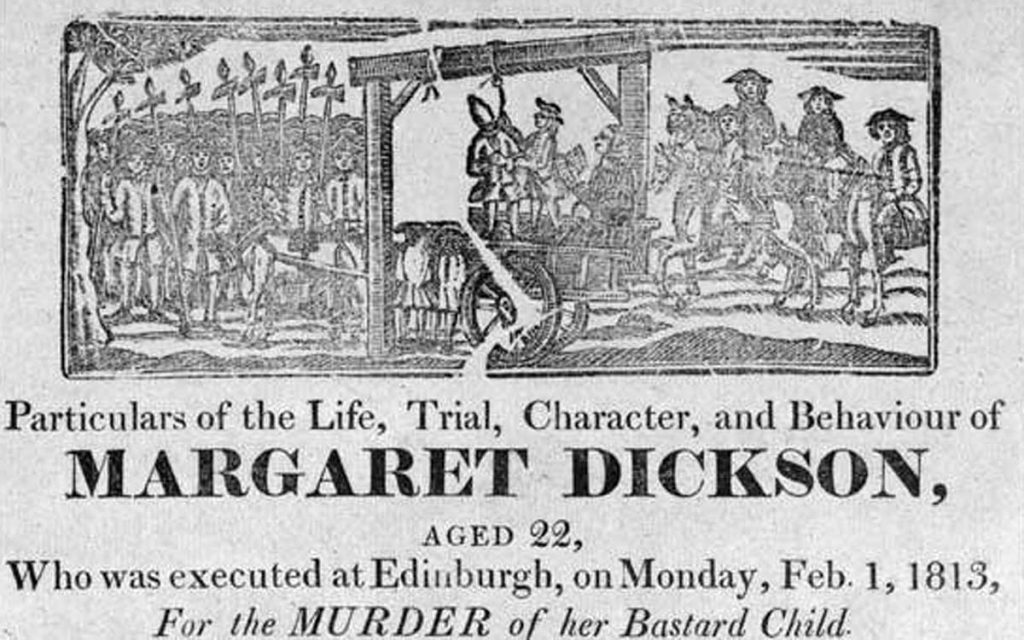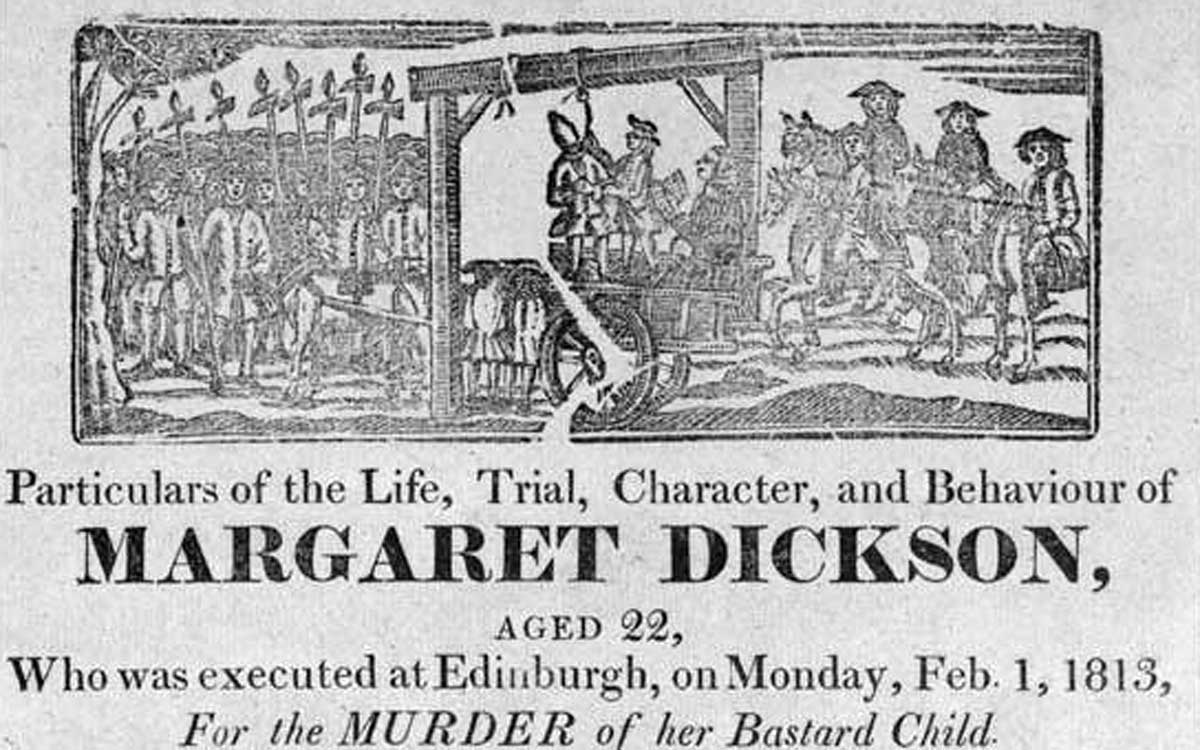Margaret Dickson was hanged for killing her baby, but survived to tell about it. TACE DORRIS reveals the strange tale of ‘Half Hangit’ Maggie!

In 1724, Margaret Dickson, of Edinburgh, was found guilty of concealing her pregnancy and killing her newborn baby.
Always maintaining her innocence, she was hanged by the neck, aged just 23.
She miraculously survived the hanging and went on to live a long, full life.
Maggie believed a God-given miracle saved her from certain death.
I think Edinburgh’s notorious hangman may have given her a helping hand on that fateful day.
Who was Margaret Dickson?
Margaret Dickson was born in Edinburgh circa 1702.
Born into a large family, she married young to a local Musselburgh fisherman, and was said to have sold their wares of salts and fish around Edinburgh City.
In 1722, Maggie’s husband vanished, most believe he was ganged onto a Navy ship.
Maggie, without sustenance and work, was said to have gone south to the Scottish Borders and found a job at an inn.
She found herself pregnant (possibly to the innkeeper’s son) but being in wedlock with an absent husband, she concealed the pregnancy and denied the rumours for as long as she could.
Baby boy found dead by river
Some days later a newborn baby boy was found on the shores of the River Tweed. All fingers pointed in Maggie’s direction.
Witnesses claimed she had been pregnant with the child and it had now disappeared.
Whether it was infanticide, a miscarriage or a tragic stillbirth, she was charged with ‘Contravention of the Concealment of Pregnancy act’. A capital crime at the time with a possible sentence of death. The trial began.
Autopsies were not what they are today and it was unclear whether the child had died pre or post-mortem.
There were no assault marks or external clues to what had happened.
In court, the senior doctor (of three) said he had put the little lungs in water and they had ‘Swimmed’.
This directed the jury to believe the babe had drawn breath.
Maggie was convicted by a male jury of her peers and sentenced to death by hanging.
Maggie awaits her fate
While awaiting her day, Maggie was said to be “Extremely penitent”.
She admitted to being guilty of ‘’fornication’’ but never of murder.
She claimed to have concealed her pregnancy for fear of being made a “public example” by her church and neighbours. Taken by labour sooner than expected, “…agonies prevented calling for assistance”.
The court paper reports, “In a state of insensibility, what became of her child she couldn’t say”.
Maggie was hanged on Edinburgh’s Grassmarket on 2 August 1724, aged only 23.
As her body was taken down a fight pursued over her body between family and the medical students of the local university.
Eventually her brother, James, put her body in a coffin on the horse carriage and headed back to Musselburgh to bury her.
The funeral party stopped at a village called Peffermill soon after for some ‘light refreshments’ and left the coffin outside.
It was noticed by two passersby that thumping was coming from the coffin.
They asked out the owners and to their horror they heard it too.
Tentatively one of them opened the coffin to see Maggie still lying as they left her.
Maggie rises from the death
Suddenly, Maggie sat bolt upright in the coffin and, “Which upon he and others took to their heels, almost killed with fear!”
Maggie recovered and is said to have then walked home with her family to Musselburgh.

Can you imagine the shock of those old neighbours on seeing her? A walking ghost, returning to haunt them!
Under Scottish law of the time, Margaret was classed as dead and could not be tried again. Her marriage was also dissolved and she was a free woman.
How did Maggie escape death?
There have been many suggestions as to how Maggie escaped death by hanging.
John Dalgleish the infamous ‘Hangman of Edinburgh’ was said to have forgotten to tie her hands before he roped her and Maggie was seen to be holding the rope with her hands as she was dropped (was she able to stop her neck from breaking?).
The crowd who watched are said to have thrown stones at the hangman, shaming him for not doing his job properly.
He moved her hands and she hung for 30 minutes.
Why would a professional hangman ‘forget’ to do his job properly?
Even on his death bed the Hangman remembered her in his last words (from a local broadside):
I’ll cry as fu’ o’ tears an egg,
‘Death, I’ve ae favour for to beg,
That ye wad only ge a flegg (fright),
And spare my life,
As I did to ill hanged Meg,
That graceless wife.

Maggie lives another 40 years
In thanks for the miracle that gave her a second chance at life, Maggie dedicated every Wednesday for the rest of her days to prayer and fasting.
She remarried her husband and they had several children together.
She lived for a further 40 years and is thought to have died around c. 1765.
Known as ‘Half Hangit’ Maggie’ to the locals and to those who heard all about her tale while traveling through Edinburgh.
There now sits a Whisky and Ale House called ‘Maggie Dickson’s’ in the Grassmarket where the gallows tried to take Maggie’s’ life.
If you ever find yourself there, raise a glass to the Woman they couldn’t hang.


